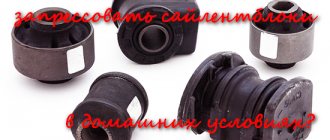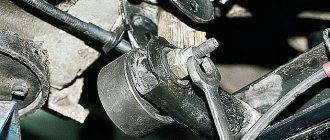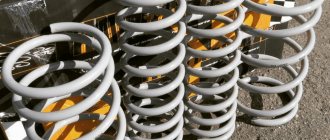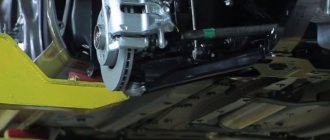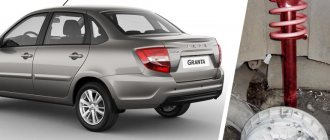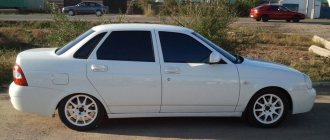Reason for replacement
The photo shows the approximate condition of the silent block, which needs to be replaced. Typical signs of wear:
- deep cracks;
- peeling of rubber from the inner or outer race.
Symptoms of breakdown that appear during vehicle operation include the appearance of knocks, impacts when driving over uneven surfaces, or asphalt joints. Diagnostic methods:
- visual inspection for the defects described above;
- place a lever between the bracket for attaching the beam to the body and the silent block, which will allow you to move the silent block in different directions. If there is a strong tear or detachment, a large play will be noticeable in the place where the silent block is pressed in relative to the mounting bracket (read more about diagnosing the vehicle chassis).
Design Features
Orientation of the Daewoo Lanos rear beam silent block
There is no fundamental difference in the silent blocks of the rear beam of different car models. A distinctive feature of a particular model can only be the requirement for the position of the silent block relative to the beam. In the photo you can see a buffer element from an Audi 80. It is recommended to press the part into the beam so that the axis of the slots is horizontal with respect to the vehicle body.
This does not apply to parts that have an all-rubber buffer, and the silent block body does not have characteristic protrusions for fastening to the bracket. They can be installed in any direction. But in any case, you should monitor the depth of pressing. Most products are pressed flush, but in some design options the silent blocks will stick out more in a certain direction (for example, on the Renault Trafic). Therefore, even during the disassembly process, you should measure the location of the part. If the buffer is not solid rubber, during disassembly, paint or scratch a mark on the silent block body and on the beam seat. This will allow you to install the silent block during assembly in exactly the same way as it was done by the manufacturer (provided that the products have not been changed before you and were installed correctly).
Useful tips
It is important to understand that malfunctions or wear of individual parts and components in the suspension device can have a strong impact on the comfort and controllability of the vehicle as a whole. In other words, if the rear silent blocks of the front levers are worn out or there are problems with the silent blocks of the rear suspension, the car may become less responsive to the steering wheel, controllability and stability will deteriorate, etc.
So, if at low speeds these negative consequences are not very noticeable, at medium or high speeds driving with failed silent blocks can be dangerous. Moreover, for fans of high-speed driving, it is completely recommended to replace standard rubber silent blocks with suitable polyurethane ones.
This will not only increase the service life of the elements, but also improve controllability and increase stability. The main thing is to choose the right replacement parts, as well as perform the installation efficiently. If you do not have the experience and tools, it is better to immediately abandon attempts at self-repair and entrust the procedure to experienced specialists.
We also recommend reading the article about what a ball joint is. From this article you will learn about the purpose, principles of operation, as well as signs of malfunction, frequent problems and features of replacing ball joints in the chassis of a car. We also note that if the car has a mileage of more than 60-70 thousand km. and chassis repairs have not been carried out previously, in this case, in addition to silent blocks, special attention should be paid to stabilizers and stabilizer struts, as well as stabilizer bushings.
If handling deteriorates, it will not be superfluous to check the shock absorbers. Only if all components and parts of the suspension are in full working order does the car receive the necessary stability, swaying, noise, vibration, etc. disappear. It also happens that even with a fully serviceable suspension, only replacing soft (for example, oil struts) with stiffer gas-oil shock absorbers allows you to qualitatively solve the problem and get the desired result.
Pressing tools and methods
At the factory, the silent block is pressed into the beam seat and is held there solely by friction. Therefore, you won’t be able to simply knock it out and get it out. It would be best to press out and press the part with a special puller. In the absence of one, you can resort to drilling out the rubber damper, which will loosen the tension a little, and cutting the outer ring with a hand hacksaw. On the Internet you can find methods in which the outer ring is bent with a chisel or a screwdriver is driven under it, and then the silent tape is knocked out of its seat. We do not recommend using such barbaric methods, as there is a risk of damaging the seat in the beam.
The design of the puller is a prefabricated mechanism consisting of mandrels, a pin and two nuts. The outer diameter of one mandrel, for which a thick washer is best suited, should match (preferably even a little smaller) with the diameter of the outer metal holder of the silent block on the press-out side. The second attachment will serve as a stop and a cavity into which the silent will go when pressed out. Its diameter must be greater than the internal diameter of the seat in the beam. As mandrels you can use large washers, bearing races, pieces of pipes of suitable diameter. There are universal wheel bearing puller kits on the market that may be suitable for repairing the rear beam.
What other tools are needed besides a puller? You need spanners and sockets for unscrewing the beam mounting brackets and the silent block itself. When completely removing the rear beam, you will need to unscrew the lower shock absorber mount and the brake hose, and you will also need keys to bleed the brake system. It is most convenient to carry out work from the inspection hole.
What will you need?
Before carrying out repair work, be sure to prepare all the necessary parts and tools. This will avoid many difficulties in the process. You will need:
- Jack;
- Set of keys and sockets;
- Hammer;
- Mandrel for silent blocks;
- Spring ties;
- Grinder (in case it is impossible to unscrew the bolts);
- Liquid key.
It is also advisable to immediately purchase new bracket mounting bolts. They are often damaged during disassembly, which makes them impossible to use further. All tools should be at hand, this will speed up the repair process.
Disassembly
Using the example of the Opel Zafia B, a method for replacing the silent blocks of the rear beam without completely removing the beam will be described.
- Loosen the nut securing the silent block to the bracket.
- Unscrew the nuts securing the bracket to the car body.
- Remove the fastening bolt and the silent itself. Don't forget to mark where the silent block was located relative to the bracket! Operations No. 1-3 should be performed on the second side as well.
- Raise the rear of the car with a jack and secure it on stands. The beam should lower slightly, after which you will have room to press out.
- Assemble the puller as shown in the photo and video. The essence of pressing out is to create the necessary force by holding the bolt on one side and tightening the nut on the other side to remove the silent block from the seat. In the video, the master drills the outer ring of the rubber damper, thereby releasing the internal tension. But note that the outer ring has a thickening that allows you to carefully drill a hole. In the case of most products, you will not be able to do this trick.
Description of the part and signs of wear
The silent block of the rear beam is a rubber-metal hinge. The part serves as an elastic insert between the car components. It consists of two bushings, between which there is a seal made of rubber or other elastic material. Recently, polyurethane has become widespread. A gasket made of elastic material allows you to dampen vibrations between components and not transfer vibrations to the car body.
The silent block of the rear beam is used not only for connecting suspension units to each other. The element is also attached to the anti-roll bar, at the mounting points of the gearbox and engine of the car. But the suspension has the most severe operating conditions due to dust, dirt, moisture and active movement of parts, so replacement is done regularly.
Visual inspection procedure:
- drive the car into a pit or lift it with a jack;
- clean the suspension mounting points from dirt;
- carry out an inspection.
Sometimes the part wears out earlier, especially when driving off-road. The degree of wear can be assessed by the behavior of the car.
Signs of wear on silent blocks:
- when driving in a straight line or when braking, the car pulls to the side;
- increased wear of rubber on the sides;
- increased vibration when driving;
- creaking or knocking in the suspension area;
- the suspension began to work harder.
The presence of one or more signs means that it is time to service the suspension. Delay can be costly. Untimely replacement will lead to loss of control in a critical situation, as well as accelerated tire wear. The hinge seats will also be damaged and then the lever will have to be replaced - this will increase the cost of repairs.
What is a silent block of a suspension arm and its functions
In car structures where there are vibrations, displacements, radial and axial loads, there must be softening special rubber parts.
They perform an important function, so they need to be changed frequently. Rubber parts that are subjected to compression, stretching, and displacement wear out quickly. A silent block is a rubber-metal hinge (RMH) in the design of a car suspension. The salent block device includes:
- two metal tubes;
- rubber connection between these tubes.
This part is made by vulcanization, which is why it has excellent vibration insulation properties. Salent blocks are capable of absorbing all types of loads that appear during vehicle operation.
If the silent blocks are heavily worn, then driving the car will be uncomfortable, noise will appear and the joints of the parts will begin to wear out faster.
Silent blocks are installed on the front and rear suspensions. They are installed on levers. In addition to levers, silent blocks connect the mounting points of the gearbox, engines and shock absorbers.
To increase reliability, it is necessary to change vibration isolation pads on time.
Where is the silent block used?
On the front axle, silent blocks are used to attach shock absorbers, anti-roll bar and torque rods. In addition, they are used to mount the engine and gearbox. On the rear axle they are mainly found in the reaction rod mounts. The standard service life of rubber-metal joints is about one hundred thousand kilometers, but very often it is significantly reduced due to the unsatisfactory quality of roads. The driving style of a particular car owner also has a significant impact on the condition of the part. As already written above, timely replacement of silent blocks is very important and, by the way, does not require a mandatory visit to a service station.
Location and principle of operation of silent blocks
Silent blocks are installed at the attachment points of the suspension arms to the body (beam, subframe). What silent blocks are needed for becomes clear from their “official” name. In the technical literature they are called rubber-metal hinges - since they are the ones who ensure the “swinging” of the arms during suspension operation. At the same time, silent blocks limit significant displacement of the levers relative to the mounting points, which could change the mounting angles of the wheels.
The role of a damper, dampening vibration and creating elastic resistance to the displacement of the levers, is played by a rubber bushing. In the figure below, the hinge joint between the lever and the body is shown in section.
Installation diagram of the lower arm silent block VAZ 2101-2107
The outer race of the silent block 2 is pressed into the lever socket. Its inner sleeve 6 is clamped between the inner and outer washers and cannot rotate freely relative to the axis. Due to the fact that the rubber bushing of hinge 1 is also clamped between the lever and its axis, rotation of the lever relative to the axis is possible only simultaneously with deformation (twisting) of the damper - the outer and inner metal bushings are welded to the rubber.
Such a tight connection of the parts ensures that unnecessary movements of the lever are limited - the axle, lever and silent block are installed without any gaps, which can cause vibration and unpleasant knocks when moving. The hinges in such suspensions are installed two per lever and complement each other. In general, depending on where this or that silent block is located, it can work differently:
- Due to the “twisting” of the rubber bushing.
- Due to compression/stretching of rubber.
In single-lever MacPherson-type suspensions, the following combination of rubber-metal hinges is often used: one works for torsion, the second connects the body with an additional lever arm, which imparts rigidity to the entire structure. The damper of the “additional” silent block works more in tension/compression.
Front suspension arm for Opel Corsa
The front silent block of such a lever is mainly needed to absorb the external impact on the wheel during suspension movements during its operation. The rear one, installed vertically, counteracts the forces directed transversely to the plane of the lever swing. Simply put, it prevents it from skewing.
This is interesting: Antifreeze leaked: causes, diagnosis, solutions
The design of such a suspension can be slightly changed - the lever (22 in the figure below) is attached to the body at one point (28), and in the transverse plane between it and the body a brace 29 is installed, also attached by means of rubber-metal hinges (30 and 22).
Scheme of fastening the suspension arm of VAZ 2108-99, VAZ 2114-15 cars
The silent block of the lever of this suspension without an external metal bushing. It is kept from turning in the socket due to the fact that it is pressed in with considerable force.
The so-called “floating” silent blocks are designed completely differently - they are, rather, ball joints:
The central bushing 6 in the middle part is made in the form of a sphere that can rotate in the plastic insert 5. The unit is filled with lubricant and closed with protective covers 1. Such a hinge is usually installed in some multi-link suspensions - in places where it is necessary to provide a greater degree of freedom in one plane and at the same time exclude mutual displacement of parts in another (in this case, in a plane perpendicular to the hinge axis). Most often used in the “steering knuckles” of rear independent suspensions (or in the reaction rods that support them).
Right choice
The choice is made after diagnosing the malfunction or during a planned replacement. It is necessary to understand what role the part plays in the suspension. Its task is to dampen vibrations that inevitably arise due to unevenness on the road.
Vibrations during movement are transmitted to the suspension springs, where they are partially damped by shock absorbers. The vibration then spreads to the frame through the connecting nodes. It is partially damped by silent blocks due to the presence of a soft base between the bushings. Therefore, the quality of the base must be of a high level. The factory version of the suspension is equipped with rubber-based silent blocks. This is a proven material, but there are better ones - for example, polyurethane.
- The service life is increased by 5 times. This allows replacements to be made after long mileage intervals and the suspension to be loaded more aggressively.
- Increased thermal stability. Polyurethane tolerates temperature changes well. The material works just as well in cold weather as at high temperatures.
- Thanks to the dense structure of the material, vehicle handling is improved.
Rubber and polyurethane are equally popular. Drivers themselves choose what to focus on. With rubber spacers you can get increased riding comfort, but improved handling can only be achieved with polyurethane. But in the latter case, comfort decreases, which is especially felt by passengers.
Garage or service station
All car owners can be divided into two categories:
- Those who carry out most of the repairs themselves in their garage, and only in emergency cases turn to a car service;
- Those who prefer not to touch anything with their own hands, but completely entrust repairs and maintenance to the masters of service stations.
Each of them is right in their own way. Therefore, we have no right to reproach those who do not want to carry out repairs themselves. After all, garage and professional repair of silent blocks, like other components, has its advantages.
STO has the following advantages:
- A high-quality, responsible car service provides a guarantee for repairs performed;
- In the event of a repeated breakdown covered by the warranty, repairs will be carried out free of charge;
- Professionals are professionals; they have extensive experience and knowledge, which allows them to competently perform their work.
But first you need to find such a car service, which, alas, is not an easy matter. Many provide a guarantee, but when you re-apply, they do everything possible to prove that the breakdown does not comply with the terms of the guarantee. A banal trick.
Repairing your garage will provide the following advantages:
- Significant financial savings, since you only have to spend money on consumables;
- The quality of the work performed by a master is always in doubt if you do not know this person personally. So self-repair may be much better than at a service station;
- You purchase the silent block, and the master only installs it. Why pay money for work that you can do yourself?!;
- Guarantee that a new one will be installed instead of the old silent block. Questionable service stations can easily install an old, more or less usable silent block instead of the one you gave them. You know what the result is.
Dismantling and installation process
Installation begins after purchasing the parts. You will need a tool - wrenches for removing the beam and suspension arms, a hammer or sledgehammer.
- The car is driven into a pit or overpass. You can lift the wheel with a jack, but it is so inconvenient to work with the suspension - you have to work lying down. The jack foot should not be in the same plane as the beam bracket.
- Dismantle the suspension beam. Be sure to remove the handbrake cable when doing this.
- The brackets have special brackets that hold the brake system hoses. The staples are removed.
- The old silent block of the beam is dismantled. Garage conditions require the use of a hammer or sledgehammer. You should work carefully so as not to damage the seat, otherwise there will be problems with installing the new part.
- The seat is cleaned of dirt and graphite lubricant is placed there.
- Install a new part. Replacement of the silent block of the rear beam is done so that there are no gaps or holes. Pressing is done with careful blows of a hammer.
- Reassemble the beam in the reverse order.
The replacement is complete and you can drive the car immediately. During assembly, you should check the installation of each part and only then proceed with assembling the next one. The silent block of the front beam is changed according to the same scheme.
Dismantling the old gum is done with 3 - 4 strong blows with a sledgehammer. You should hit strictly in the center of the part, without deviating to the side from the vertical axis. The edge of the clip is bent using a chisel to facilitate dismantling.
Experienced craftsmen use a piece of tube to press out the silent block of the rear beam. It is important that its diameter is slightly smaller than the same parameter of the seat. The tube is placed against the part and hit with a hammer. In a few blows the part will be removed without unnecessary operations.
DIY puller
Dismantling and pressing in a new part are difficult stages of work, especially the last one. Therefore, the installation of silent blocks of the rear beam should be performed using a special device - a puller. You can make it yourself or ask a friend. With it you do not need to hit the parts with a hammer, so damage cannot be caused.
Device options:
- Small vices. They are put on the suspension part, and a tube is placed under one of the sides. It is important to install the second part so that it presses on the body of the part. But a piece of wood is installed between the vise lip and the part.
- Homemade device from scrap materials. This option involves turning and welding. Make a clamp from metal plates or improvised means. A hole is drilled in the base, where a nut is usually welded. A bolt is installed here, which serves as a press.
- Purchase of factory tools.
The option with a vice is the simplest and most reliable. A factory product costs money. If they are not there, but you have the skills and parts, then you can make the tool yourself. It is important that it can withstand high loads.
Let's sum it up
Taking into account the above information, it becomes clear that replacing the silent blocks of the front arms or silent blocks of the rear suspension is an important and responsible procedure. At the same time, the replacement itself is quite simple, provided that you have the appropriate tool for removal and pressing. However, if there is no such tool, when performing work using other methods there is a risk of damaging both the lever itself and the new silent block.
We also recommend reading the article on how to check the engine mount. In this article you will learn what an engine mount is and how it works, as well as how to check an engine mount. Finally, we note that when selecting silent blocks for replacement, you should immediately decide what to install, a rubber or polyurethane silent block. The fact is that the first option is more suitable for a quiet ride, but can fail faster. In turn, the second type lasts longer and improves handling somewhat, but is more expensive and can creak.
One way or another, the car owner himself must take into account these and other features discussed above before replacing. You should also make allowances for individual operating conditions, driving style, etc. Only this approach allows you to achieve better controllability and stability of the car on the road, both at medium and high speeds.
Signs of wear
With a careful driving style, new silent blocks can last quite a long time. Manufacturers usually produce vibration isolators with a large margin of safety, guaranteeing their stable operation for a long time (up to 90-100 thousand kilometers). However, an aggressive driving style combined with poor quality road surfaces significantly reduces the service life of parts. Wear of the silent blocks of the rear beam is often indicated by uneven wear of the rubber and poor stability of the vehicle when turning. The appearance of squeaks in the rear of the car body and impacts on it while driving on poor-quality road surfaces also indicate that the rear beam silent blocks need immediate replacement. It should be remembered that the appearance of the symptoms described above may be inherent in the presence of any other defects, therefore it is imperative to carry out thorough diagnostic work on the entire rear part of the body.
How do you know when it's time to change silent blocks?
What signs and symptoms indicate that the front suspension arm bushings or rear beam bushings need to be replaced?
Failures can manifest themselves as follows:
- the car begins to react poorly to steering turns;
- extraneous sounds, tapping, etc. are heard;
- at high speeds the car pulls to the side is noticeable;
- Uneven tire wear is noticeable.
If you feel any of the above, then replacing the silent blocks is already necessary. To do this, you can visit a car service center, where specialists will do everything, or you can deal with the problem yourself. Let's look at how to do this below.
Symptoms of a problem
How to determine that a car needs to replace the rear silent block of the rear beam? The main feature is the nature of the suspension. As you drive, you will feel squeaks and bumps in the rear of the car. They will get stronger every day.
Externally, this can be determined by the displacement of the central bushing of the silent block or the breakage of the rubber lining. If the vehicle has been used carefully, the part may fail due to normal wear and tear. So, after 5-7 years the rubber begins to “tan”. The silent block ceases to be so elastic and begins to play.
If the problem is ignored, uneven tire wear may occur (due to beam misalignment and rear wheel alignment angle violations). The car will lose its previous controllability - it will skid when turning.
Diagnostics – how to identify a problem or make sure it doesn’t exist?
- We drive into the “pit” or lift the vehicle using a jack.
- Remove the ball joints.
- We check the parts whose operation is related to the silent block. We swing the suspension arm to the sides: you need to make sure that it does not “fall”. The lever should spring back to its natural position (if it is working properly).
- Checking the bushing. It should not be observed to rotate relative to the eyes.
- We check the silent block directly: for knocking inside the element, as well as for the presence of visible mechanical damage and cracks (note: on rubber and metal).
- We check to see if there is any play. Its presence is a signal for an urgent replacement of the element.
Who can check the condition of silent blocks
- Service center specialist. It is realistic to contact a person who specializes in repairing your brand of car to get advice on how to check the silent blocks on a VAZ 2110. And with an expert assessment, decide whether it is worth replacing the parts, or whether they are in acceptable condition, so they can still be used exploit. It is possible to get a full range of services from a specialist: undergo vehicle diagnostics, discuss possible cooperation, receive a set of new parts for installation and pick up the car from the site, absolutely ready for use on the roads. On average, for the work of a service specialist, you will be asked for somewhere between 500-1000 rubles, but this does not take into account the material necessary for replacement.
- Car owner. He himself is able to independently inspect and replace the silent blocks as necessary. It is possible to decide on this if you clearly and competently understand how to check the silent blocks of the rear beam of the VAZ 2110. You should be aware that the silent blocks for the VAZ 2110 are very important; they necessarily affect the wheel alignment angles. And if you skip the moment of diagnosing these small parts, the result is disastrous - the VAZ 2110’s suspension mounts and all important connections will break and unwanted play will appear. It is not recommended to carry out an inspection yourself for the first time; it is worth contacting friends who are already familiar with the situation and clearly understand how to check the silent blocks on a VAZ 2110; they, of course, watched the profile video. Let us note that by doing the repairs yourself, you will save money, but perhaps such precious time will become more costly than if the work was done at a service center. On average, spend 100-160 rubles per part to purchase new silent blocks and mounts for the rear suspension. If you don’t have the necessary tools in the garage, you’ll have to borrow them or buy them. So there will be another expense item. And the car can be unpredictable, because there are situations when you are repairing one thing, and at the same moment a new problem pops up, and it will also have to be eliminated.
This is interesting: Oil scraper rings and caps - replacement if stuck, decarbonization
Buying new silent blocks
New
When purchasing new silent blocks, it is best to get qualified advice from specialists representing a particular automobile store. This is explained by the fact that vibration isolators designed for various car models are practically no different from each other visually, but have different outer diameters.
Before you start replacing the silent blocks of the rear beam yourself, you need to take care of purchasing a special puller. If for some reason you cannot purchase this tool, you can make it yourself.
Step-by-step replacement process
Rear beam silent block
- Vibration isolators need to be replaced after the car is installed on a special lift, overpass or inspection pit. The wheels of the vehicle must be securely secured with anti-roll chocks.
- To ensure good access to the part being replaced, the rear wheel must be removed.
- Next, the brake regulator rod (located on the left side) is disconnected from the rear beam, after which you need to move the hand brake cable (located on the right side).
- Using a wrench with a jaw size of 19 mm, unscrew the nut of the fastening bolt connecting the rear beam and the bracket.
- Next, using a lifting mechanism (jack), the vehicle body is raised, and the beam eye is moved down.
- At the next stage, a wooden beam is installed between the beam and the car body, after which you can dismantle the silent block that needs to be replaced using a special puller.
- Before installing a new silent block, the seat is thoroughly cleaned of dust, dirt and corrosion, lubricated with a solution of water and soap, after which the new silent block is pressed in using a puller.
- When all the steps described above have been completed, you need to begin assembling the car in the reverse order.
- After the work carried out, the alignment angles of the vehicle wheels are restored.
What happens if the silent blocks are not changed on time?
When the part wears out, a gradually increasing play appears (in the block seat). As a result, the sleeve hole is also developed. This is fraught with:
- pulling the car to the side at high speed;
- increased and uneven tire wear;
- poor handling, especially noticeable when cornering;
- the appearance of a feeling of discomfort when moving, because hitting even small obstacles will bring unpleasant sensations.
